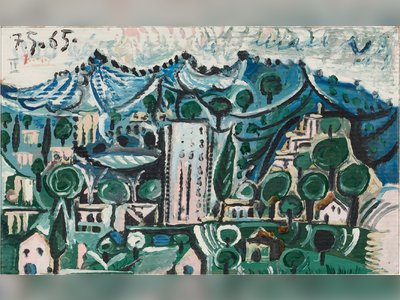
Sotheby’s and Christie’s Reimagined Auctions Pay Off
Major auction houses are investing in digital and shaking up their sales categories and timings, in part to draw a global audience.
What was an evening event is now an afternoon one. Degas and van Gogh are now 20th-century Modernists. Six-figure prices are few and far between.
This new reality was clear during Sotheby’s and Christie’s marquee summer live-streamed “evening” auctions of modern and contemporary art in post-Brexit London, which this year started at 2 p.m. on Tuesday and Wednesday to make sure wealthy bidders in Asia were awake.
“We live in a world that’s more global than ever,” said Melanie Clore, co-founder of the London-based art advisory company Clore Wyndham.
“There is big growth in Hong Kong,” said Clore, who once served as a chairwoman of Sotheby’s Impressionist and modern art department in London. “There is a new wave of young people in Asia who have a lot of disposable money. Tastes have changed.”
On Tuesday, Sotheby’s two-part livestream auction of British and international works of modern and contemporary art in London raised a combined 156.2 million pounds with fees, or about $215 million, from 91 lots. Bolstered by the inclusion of modern British works, this represented a decrease of 11 percent on the total proceeds from its equivalent prepandemic evening sales of British and international art in June 2019.
Sotheby’s and Christie’s auction categories have gone through a dramatic shake-up in London. Last summer, with the pandemic choking both demand and supply, and with 19th-century art having fallen out of fashion, Christie’s and Sotheby’s both abandoned their traditional stand-alone evening sales of Impressionist, modern and contemporary art, and experimented with innovative part-live, part-online auctions that merged 20th- and 21st-century material to adapt to the changing tastes of younger, international collectors.
Sotheby’s, like Christie’s, no longer offers specialist selections of big-ticket Impressionist art in London. The occasional late-19th-century gem, like a Degas or van Gogh drawing, is still included in evening auctions of 20th- and 21st-century material, if of high enough value. This week, for example, Sotheby’s sold an 1883 Degas pastel of a woman bathing for £2.7 million, or $3.7 million, and Christie’s an 1885 van Gogh drawing of a man digging potatoes for £862,000, or about $1.2 million. Phillips didn’t hold any major art auctions in London in June, focusing instead on the inaugural sales at its new New York headquarters.
“London is down,” said Christine Bourron, chief executive of Pi-eX, a London-based research company that tracks the performance of international art auctions. “It needs to reinvent itself. Brexit is making the trade more difficult.”
Aggregate Sotheby’s, Christie’s and Phillips auctions in London raised $1.2 billion in the first half of 2021, according to Pi-eX data, compared with $1.5 billion in the same period in 2019. Equivalent auction sales in Hong Kong grew to about $1.3 billion, up from $892 million. First half sales in Paris in 2021 totaled $409 million, up from $229 million in 2019.
At the moment, it remains difficult to disentangle the effects of the Covid pandemic and Brexit on the British art market. But it is clear that auction houses with bases in London are already reinventing themselves by coming up with new sale formats, as well as looking further afield. Sotheby’s is opening a new headquarters in Cologne, Germany, and is transferring Alex Branczik, its London-based head of contemporary art, to Hong Kong. Christie’s live-streamed London auctions of 20th- and 21st-century art are now routinely paired with sister offerings in Paris.
Sotheby’s and Christie’s historic auction rooms have now been transformed into TV studios for their live-streamed sales, leaving limited space for a small invited audience. Today’s digitized top-end art auctions are all about selling to global clients, and London has become effective at it, helped in part by a plethora of guaranteed minimum prices to sellers and by a favorable position in the international time zones.
“London is a place where everyone can be comfortable at a global auction,” Bourron said. “New York is painful for Asian collectors and Hong Kong is painful for Americans.”
Lot 1 at Sotheby’s set the tone. “I’m pirouetting the night away,” a vibrant blue-and-orange 2019 abstract by the young British painter Jadé Fadojutimi, drew multiple bids from Hong Kong before selling for £402,200, or about $553,000, four times the pre-sale estimate.
These London sales also continue to attract some impressive works by the blue-chip names of European 20th-century art. Sotheby’s Tuesday modern and contemporary offerings included “Tensions calmées,” a 1937 example of the more playful geometric paintings that Wassily Kandinsky made in France toward the end of his life. From a U.S. collection, and not seen at auction for more than 50 years, this sold to a telephone bidder represented in London for £21.2 million pounds, or nearly $30 million, making it the most expensive lot of the week for either house.
Sotheby’s buoyed its evening proceeds with a sale of British Modern and contemporary art, which also benefited from exposure to an international online audience, adding £48.2 million to the total, or about $66 million.
On Wednesday, Christie’s 51-lot “evening” livestream of 20th- and 21st-century art in London was viewed by experts as having the edge over Sotheby’s. Its total of £119.3 million, or about $164 million, represented a 46 percent improvement on the equivalent Impressionist, modern and contemporary sales in June 2019.
Its success was in large part because of a delicate 1951 Giacometti bronze sculpture, “Homme qui chavire,” which raised £13.7 million, or about $19 million; and the 1969 Picasso painting, “L’Étreinte,” which had never been offered at auction before and earned the top price of the night with £14.7 million, or over $20 million, to a telephone bid from New York.
“It was a big blingy Picasso that appealed to contemporary tastes,” said Hugo Nathan, co-founder of Beaumont Nathan, a London-based advisory company. “Late Picassos used to be in day sales, but now they’re easier to sell than his Cubist or Blue Period works.”
The London auction was immediately followed by a further 40 lots in Paris, Britain and France, combining to form an unlikely post-Brexit tag team. The Paris sale was headlined by 24 pieces from the collection of 20th-century works quietly acquired by the French entrepreneur Francis Gross, who died in 1992.
This consisted mainly of relatively minor works by major names — though did include the 1936 René Magritte painting, “La vengeance,” a work never offered at auction before and which sold for 14.6 million euros, or about $17.3 million, the highest auction price achieved so far this year for a painting in France, according to Christie’s.
In total, Paris’s proceeds represented less than half the total achieved at the Christie’s London sale, showing that Paris still has some way to go to replace London as the capital of Europe’s post-Brexit art market.
“Paris has tried to become the center of the European art trade, but the auctions are better in London,” said Marco Voena, co-founder of Robilant + Voena, a dealership with spaces in London, Milan, New York and Paris. “People are confident in London, even though there have been big problems. It’s tradition.”
This new reality was clear during Sotheby’s and Christie’s marquee summer live-streamed “evening” auctions of modern and contemporary art in post-Brexit London, which this year started at 2 p.m. on Tuesday and Wednesday to make sure wealthy bidders in Asia were awake.
“We live in a world that’s more global than ever,” said Melanie Clore, co-founder of the London-based art advisory company Clore Wyndham.
“There is big growth in Hong Kong,” said Clore, who once served as a chairwoman of Sotheby’s Impressionist and modern art department in London. “There is a new wave of young people in Asia who have a lot of disposable money. Tastes have changed.”
On Tuesday, Sotheby’s two-part livestream auction of British and international works of modern and contemporary art in London raised a combined 156.2 million pounds with fees, or about $215 million, from 91 lots. Bolstered by the inclusion of modern British works, this represented a decrease of 11 percent on the total proceeds from its equivalent prepandemic evening sales of British and international art in June 2019.
Sotheby’s and Christie’s auction categories have gone through a dramatic shake-up in London. Last summer, with the pandemic choking both demand and supply, and with 19th-century art having fallen out of fashion, Christie’s and Sotheby’s both abandoned their traditional stand-alone evening sales of Impressionist, modern and contemporary art, and experimented with innovative part-live, part-online auctions that merged 20th- and 21st-century material to adapt to the changing tastes of younger, international collectors.
Sotheby’s, like Christie’s, no longer offers specialist selections of big-ticket Impressionist art in London. The occasional late-19th-century gem, like a Degas or van Gogh drawing, is still included in evening auctions of 20th- and 21st-century material, if of high enough value. This week, for example, Sotheby’s sold an 1883 Degas pastel of a woman bathing for £2.7 million, or $3.7 million, and Christie’s an 1885 van Gogh drawing of a man digging potatoes for £862,000, or about $1.2 million. Phillips didn’t hold any major art auctions in London in June, focusing instead on the inaugural sales at its new New York headquarters.
“London is down,” said Christine Bourron, chief executive of Pi-eX, a London-based research company that tracks the performance of international art auctions. “It needs to reinvent itself. Brexit is making the trade more difficult.”
Aggregate Sotheby’s, Christie’s and Phillips auctions in London raised $1.2 billion in the first half of 2021, according to Pi-eX data, compared with $1.5 billion in the same period in 2019. Equivalent auction sales in Hong Kong grew to about $1.3 billion, up from $892 million. First half sales in Paris in 2021 totaled $409 million, up from $229 million in 2019.
At the moment, it remains difficult to disentangle the effects of the Covid pandemic and Brexit on the British art market. But it is clear that auction houses with bases in London are already reinventing themselves by coming up with new sale formats, as well as looking further afield. Sotheby’s is opening a new headquarters in Cologne, Germany, and is transferring Alex Branczik, its London-based head of contemporary art, to Hong Kong. Christie’s live-streamed London auctions of 20th- and 21st-century art are now routinely paired with sister offerings in Paris.
Sotheby’s and Christie’s historic auction rooms have now been transformed into TV studios for their live-streamed sales, leaving limited space for a small invited audience. Today’s digitized top-end art auctions are all about selling to global clients, and London has become effective at it, helped in part by a plethora of guaranteed minimum prices to sellers and by a favorable position in the international time zones.
“London is a place where everyone can be comfortable at a global auction,” Bourron said. “New York is painful for Asian collectors and Hong Kong is painful for Americans.”
Lot 1 at Sotheby’s set the tone. “I’m pirouetting the night away,” a vibrant blue-and-orange 2019 abstract by the young British painter Jadé Fadojutimi, drew multiple bids from Hong Kong before selling for £402,200, or about $553,000, four times the pre-sale estimate.
These London sales also continue to attract some impressive works by the blue-chip names of European 20th-century art. Sotheby’s Tuesday modern and contemporary offerings included “Tensions calmées,” a 1937 example of the more playful geometric paintings that Wassily Kandinsky made in France toward the end of his life. From a U.S. collection, and not seen at auction for more than 50 years, this sold to a telephone bidder represented in London for £21.2 million pounds, or nearly $30 million, making it the most expensive lot of the week for either house.
Sotheby’s buoyed its evening proceeds with a sale of British Modern and contemporary art, which also benefited from exposure to an international online audience, adding £48.2 million to the total, or about $66 million.
On Wednesday, Christie’s 51-lot “evening” livestream of 20th- and 21st-century art in London was viewed by experts as having the edge over Sotheby’s. Its total of £119.3 million, or about $164 million, represented a 46 percent improvement on the equivalent Impressionist, modern and contemporary sales in June 2019.
Its success was in large part because of a delicate 1951 Giacometti bronze sculpture, “Homme qui chavire,” which raised £13.7 million, or about $19 million; and the 1969 Picasso painting, “L’Étreinte,” which had never been offered at auction before and earned the top price of the night with £14.7 million, or over $20 million, to a telephone bid from New York.
“It was a big blingy Picasso that appealed to contemporary tastes,” said Hugo Nathan, co-founder of Beaumont Nathan, a London-based advisory company. “Late Picassos used to be in day sales, but now they’re easier to sell than his Cubist or Blue Period works.”
The London auction was immediately followed by a further 40 lots in Paris, Britain and France, combining to form an unlikely post-Brexit tag team. The Paris sale was headlined by 24 pieces from the collection of 20th-century works quietly acquired by the French entrepreneur Francis Gross, who died in 1992.
This consisted mainly of relatively minor works by major names — though did include the 1936 René Magritte painting, “La vengeance,” a work never offered at auction before and which sold for 14.6 million euros, or about $17.3 million, the highest auction price achieved so far this year for a painting in France, according to Christie’s.
In total, Paris’s proceeds represented less than half the total achieved at the Christie’s London sale, showing that Paris still has some way to go to replace London as the capital of Europe’s post-Brexit art market.
“Paris has tried to become the center of the European art trade, but the auctions are better in London,” said Marco Voena, co-founder of Robilant + Voena, a dealership with spaces in London, Milan, New York and Paris. “People are confident in London, even though there have been big problems. It’s tradition.”











